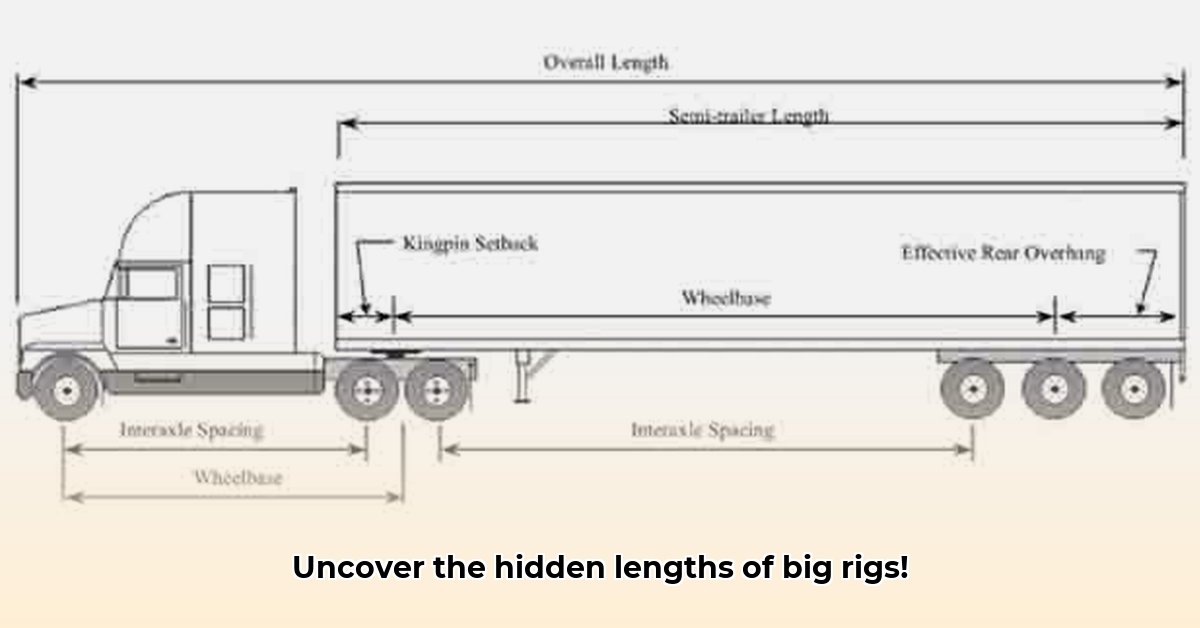
Average Dimensions: A Starting Point
The length of a tractor-trailer isn't a single number. A typical combination measures approximately 70 to 72 feet long, 8.5 feet wide, and 13.5 feet high. However, these are averages; significant variations exist. Understanding these variations is crucial for safe and efficient operation. Why is this variability so important? Because exceeding length and weight limits can lead to serious consequences. For more detailed information, check out this helpful resource on tractor-trailer dimensions.
Factors Affecting Length and Weight
Several key factors influence a semi-truck's overall dimensions and its allowable weight:
Trailer Type
The trailer type significantly impacts length and weight capacity. A standard dry van trailer (the enclosed box-like trailer) is typically 53 feet long. However, other types include:
Refrigerated Trailers (Reefers): Often slightly longer than dry vans, typically 53-57 feet, due to added refrigeration units. This increased length and added weight of the refrigeration unit changes the overall weight capacity.
Flatbed Trailers: Length varies greatly depending on the cargo. They can range from relatively short to over 80 feet for oversized loads. Weight capacity is highly variable, depending on the load's weight distribution and the ability to properly secure that load.
Pup Trailers: These shorter trailers, around 28 feet, are used for smaller shipments, greatly impacting overall length and weight.
Tractor Cab Type
The tractor cab contributes to the overall length. Sleeper cabs, offering sleeping space for drivers, are substantially longer than day cabs, designed for shorter hauls. This difference in length influences the overall length of the semi-truck combination.
State Regulations
State regulations impose length limits, which vary significantly. These restrictions directly impact allowable lengths and potentially the type of trailers that can be used within a specific state. Compliance is paramount to avoid fines and delays.
State-by-State Length Limits: A Summary
Precise and up-to-the-minute data requires consulting each state's Department of Transportation. However, the following table offers a general overview of potential variations (Always verify with official sources):
| State | Approximate Maximum Length (feet) | Notes |
|---|---|---|
| California | 65 | Specific rules for configurations may apply. |
| Texas | 75+ | Exceptions and variations exist. |
| Florida | Varies widely | Length depends heavily on the specific setup. |
| New York | 75 | Exceptions are dependent on circumstances. |
| Oregon | 75+ | Special permits might be required for long trucks. |
| Many States | 65-75 | Always double-check your specific state's rules. |
Weight Considerations: A Critical Factor
Weight limitations are just as crucial as length restrictions. These restrictions are designed to enhance safety and prevent dangerous overloading.
GVWR (Gross Vehicle Weight Rating): The maximum weight of the truck and its payload. This figure will vary by the tractor and trailer specifications.
GCWR (Gross Combined Weight Rating): The maximum safe weight of the entire truck and trailer combination. This is always less than the sum of the GVWR for the tractor and the trailer.
GAWR (Gross Axle Weight Rating): The maximum weight allowed on each axle. Exceeding this is dangerous and illegal.
Understanding these ratings and adhering to them is critical to prevent mechanical failures, reduce braking performance issues, and avoid legal penalties.
Legal Compliance: The Importance of Adherence
Adhering to federal and state regulations regarding dimensions and weight is not optional; it's essential for safety. Consequences of non-compliance include substantial fines, operational disruptions, and potential accidents. Regular vehicle inspections are crucial to maintain compliance.
Practical Applications: Actionable Advice
This section provides advice tailored to different stakeholders:
Fleet Managers: Invest in route-planning software that considers dimensions and weight restrictions for optimized routes and to prevent violations.
Truck Drivers: Conduct thorough pre-trip inspections. Understand the regulations for the states you will be traveling through. Frequent use of certified scales is highly recommended.
Transportation Companies: Implement comprehensive driver training programs that emphasize the importance of size and weight regulations.
Regulatory Bodies: Consistent nationwide regulations will improve efficiency, safety, and reduce complexity for all stakeholders.
Conclusion: Navigating the Dimensions of Safety
The length of a tractor-trailer is far from a simple answer. Understanding the contributing factors—trailer type, cab type, and state regulations—is crucial for safe and efficient operations. Prioritizing legal compliance and employing proactive weight management strategies safeguards against penalties, accidents, and operational disruptions. Always refer to official sources for the most up-to-date and accurate information.